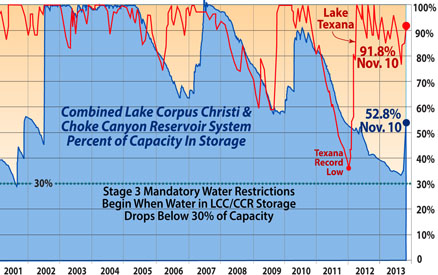October 31, 2013
A major rainfall event in the Nueces River Basin 150 miles west of the Corpus Christi Bay area on October 13th sent a wave of flood waters flowing downstream and by the end of October Lake Corpus Christi was filled to capacity.
Lake Corpus Christi (LCC), which had been holding steady at about 25% of capacity for the past five months, began seeing inflows on October 19th. The lake was last full briefly in 2010.
Inflows from this event filled LCC to its capacity of 257,000 acres (compared to 68,000 acre feet in storage on Oct.19th). River flows at Tilden peaked at 36,000 cubic feet per second on Oct. 18th, the third highest crest ever recorded at that location.
The Oct. 13th rain event included in 6 to 8 inches over Dimmit, La Salle and part of Webb County, north of Laredo. Crystal City had almost 14 inches and Carrizo Springs reported 9.6 inches. The signficant rainfall did not extend eastward into the Frio River watershed upstream from Choke Canyon Reservoir.
The complete filling of Lake Corpus Christi is a dramatic reversal of water supply storage conditions in the Nueces Basin. As of Oct. 18th the combined storage of Lake Corpus Christi and Choke Canyon Reservoir stood at 32.8% and was threatening to send the region’s water customers into Stage 3 mandatory water restrictions. An overflowing Lake Corpus Christi has push the combined LCC/CCR total to more than 53% of capacity for the first time since June 2012.
Coastal Bend water customers have been under Stage 2 water restrictions since June, 2013, when storage in LCC/CCR dropped to below 40% of combined capacity. By mid-October the region was within a couple of months of State 3 which is triggered at 30%.
With Lake Corpus Christi full and the combined level over 50% it is likely even with no additional inflows in the Nueces Basin that combined capacity will stay about 30% until sometime in the first half of 2016.
Rainfall from autumn frontal passages has also contributed inflows to Lake Texana on the Navidad River east of Victoria. It was down to 75% of capacity in mid-September but had bounced back to over 90% by early November.
November 10, 2013 Update:









